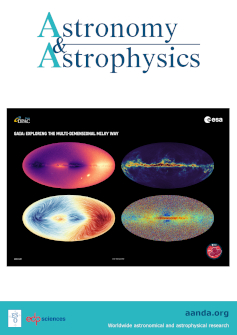X-Shooting ULLYSES: Massive stars at low metallicity
IF 5.4
2区 物理与天体物理
Q1 ASTRONOMY & ASTROPHYSICS
引用次数: 0
Abstract
Context. The XShootU project aims to obtain ground-based optical to near-infrared spectroscopy of all targets observed by the Hubble Space Telescope (HST) under the Director’s Discretionary program ULLYSES. Using the medium-resolution spectrograph X-shooter, spectra of 235 OB and Wolf-Rayet (WR) stars in subsolar metallicity environments have been secured. The bulk of the targets belong to the Large and Small Magellanic Clouds, with the exception of three stars in NGC 3109 and Sextans A.Aims. This second paper in the series focuses on the optical observations of Magellanic Clouds targets. It describes the uniform reduction of the UVB (300–560 nm) and VIS (550–1020 nm) XShootU data as well as the preparation of advanced data products that are suitable for homogeneous scientific analyses.Methods. The data reduction of the RAW data is based on the ESO CPL X-shooter pipeline. We paid particular attention to the determination of the response curves. This required equal flat-fielding of the science and flux standard star data and the derivation of improved flux standard models. The pipeline products were then processed with our own set of routines to produce a series of advanced data products. In particular, we implemented slit-loss correction, absolute flux calibration, (semi-)automatic rectification to the continuum, and a correction for telluric lines. The spectra of individual epochs were further corrected for the barycentric motion, re-sampled and co-added, and the spectra from the two arms were merged into a single flux-calibrated spectrum covering the entire optical range with maximum signal-to-noise ratio.Results. We identify and describe an undocumented recurrent ghost visible on the RAW data. We present an improved flat-fielding strategy that limits artifacts when the SCIENCE and FLUX standard stars are observed on different nights. The improved FLUX standard models and the new grid of anchor points limit artifacts of the response curve correction, for example on the shape of the wings of the Balmer lines, from a couple of per cent of the continuum level to less than 0.5%. We confirm the presence of a radial velocity shift of about 3.5 km s−1 between the UVB and the VIS arm of X-shooter and that there are no short term variations impacting the RV measurements. RV precision better than 1 km s-1 can be obtained on sharp telluric lines while RV precision on the order of 2 to 3 km s-1 is obtained on data with the best S/N.Conclusions. For each target observed by XShootU, we provide three types of data products: (i) two-dimensional spectra for each UVB and VIS exposure before and after correction for the instrument response; (ii) one-dimensional UVB and VIS spectra as produced by the X-shooter pipeline before and after response-correction, and applying various processing, including absolute flux calibration, telluric removal, normalization and barycentric correction; and (iii) co-added flux-calibrated and rectified spectra over the full optical range, for which all available XShootU exposures were combined. For the large majority of the targets, the final signal-to-noise ratio per resolution element is above 200 in the UVB and in the VIS co-added spectra. The reduced data and advanced scientific data products are made available to the community. Together with the HST UV ULLYSES data, they should enable various science goals, from detailed stellar atmosphere and stellar wind studies, and empirical libraries for population synthesis, to the study of the local nebular environment and feedback of massive stars in subsolar metallicity environments.X-Shooting ULLYSES:低金属性大质量恒星
背景。XShootU项目旨在获得哈勃太空望远镜(HST)在局长酌处计划ULLYSES下观测到的所有目标的地基光学到近红外光谱。利用中分辨率摄谱仪X-shooter,已经获得了235颗处于亚太阳金属性环境中的OB星和Wolf-Rayet(WR)星的光谱。大部分目标属于大麦哲伦云和小麦哲伦云,只有 NGC 3109 和 Sextans A 中的三颗恒星除外。本系列的第二篇论文重点介绍麦哲伦云目标的光学观测。它介绍了对 UVB(300-560 nm)和 VIS(550-1020 nm)XShootU 数据的统一缩减,以及适合同质科学分析的高级数据产品的制备。对 RAW 数据的还原基于 ESO CPL X-shooter 管道。我们特别关注响应曲线的确定。这需要对科学星数据和通量标准星数据进行同等平场处理,并推导出改进的通量标准模型。然后用我们自己的一套程序对管道产品进行处理,以产生一系列先进的数据产品。特别是,我们实施了狭缝损耗校正、绝对通量校准、连续面(半)自动校正和碲线校正。单个纪元的光谱还进一步进行了偏心运动校正、重新采样和合并,来自两臂的光谱被合并成一个单一的通量校正光谱,以最大信噪比覆盖整个光学范围。我们发现并描述了 RAW 数据中可见的一个未记录的经常性幽灵。我们提出了一种改进的平场策略,可以限制在不同夜晚观测 SCIENCE 和 FLUX 标准星时产生的伪影。改进后的 FLUX 标准模型和新的锚点网格限制了响应曲线校正的伪影,例如巴尔默线的翼形,从连续波水平的百分之几降低到 0.5%以下。我们证实在 X-shooter 的 UVB 和 VIS 臂之间存在约 3.5 km s-1 的径向速度偏移,并且没有短期变化影响 RV 测量。在尖锐的碲线上可以获得优于 1 千米/秒的 RV 精度,而在具有最佳信噪比的数据上可以获得 2 至 3 千米/秒的 RV 精度。对于 XShootU 观测到的每个目标,我们都提供了三种类型的数据产品:(i) 仪器响应校正前后每次 UVB 和 VIS 曝光的二维光谱;(ii) 响应校正前后由 X-shooter 管道生成的一维 UVB 和 VIS 光谱,并应用了各种处理,包括绝对通量校准、碲去除、归一化和偏心校正;以及 (iii) 全光学范围内的共加通量校准和校正光谱,其中所有可用的 XShootU 曝光都合并在一起。对于绝大多数目标,在 UVB 和 VIS 共加光谱中,每个分辨率元素的最终信噪比都在 200 以上。缩减后的数据和高级科学数据产品已向社会公布。这些数据与 HST 紫外 ULLYSES 数据一起,可以实现各种科学目标,从详细的恒星大气和恒星风研究、用于种群合成的经验库,到本地星云环境研究和亚太阳金属性环境中大质量恒星的反馈。
本文章由计算机程序翻译,如有差异,请以英文原文为准。
求助全文
约1分钟内获得全文
求助全文
来源期刊

Astronomy & Astrophysics
地学天文-天文与天体物理
CiteScore
10.20
自引率
27.70%
发文量
2105
审稿时长
1-2 weeks
期刊介绍:
Astronomy & Astrophysics is an international Journal that publishes papers on all aspects of astronomy and astrophysics (theoretical, observational, and instrumental) independently of the techniques used to obtain the results.
文献相关原料
| 公司名称 | 产品信息 | 采购帮参考价格 |
|---|
 求助内容:
求助内容: 应助结果提醒方式:
应助结果提醒方式:


